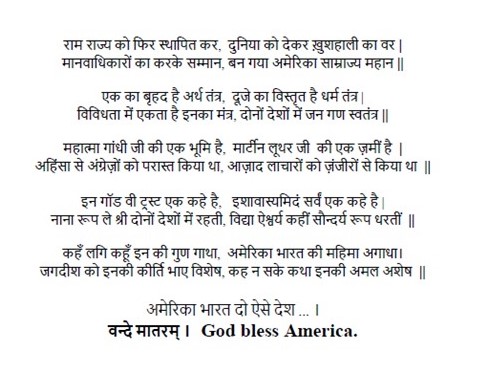Archive for category April 2019
Bharat aur America — Indian and the USA
Posted by admin in April 2019, Past issues on April 12, 2019
Ha!! Gatecrashing in Weddings in India
Posted by admin in April 2019, Past issues on April 7, 2019
By Kollengode S Venkataraman, Monroeville, PA
Gatecrashing in American weddings are rare simply because typically, weddings in the US have a much smaller cozier gathering. But they are not unheard of. However, in the US crashing in the year-end Christmas and New Year parties in large fancy hotels are more common, and by one account, it is on the rise. See www.tinyurl.com/US-gate-crashing.
Crashers strategically camp out in upscale hotel lobbies looking for parties in large ballrooms. Many online groups even advise people on how to gatecrash company parties successfully! Here are the tips:
1. Dress appropriately — Wear a suit to blend in.
2. Show up fashionably late.
3. Don’t coat check. This helps to leave quickly.
5. Don’t take the company gift. Sometimes there’s only enough for actual employees.
6. Don’t overindulge and avoid drawing much attention to yourself.

But in Desi weddings, where the number of invitees is nearly 400 to 600 people, or even larger (if it is in India), gatecrashing is far more common.
Sources in the National Institute of Technology, Kurukshetra, UP, in India said that officials at the wedding halls nearby have complained that students have been gatecrashing weddings to skip meals in the mess, which is why this directive was issued.
The letter directed students to desist from indulging in such type of “uncivilised activities†which also brings a bad name to the institution. The letter warned students of disciplinary action if they are found to indulge in this behavior in future. “Disciplinary action as per the institute rules will be taken against the students if they are found indulging in such an activity,†the letter said.
One thing the NIT Mess can do to prevent this behavior of its students is to improve the quality, flavor and variety of the food they serve in the students canteen!!
Celebrating the Spiritual Wisdom of Indian Scriptures
Posted by admin in April 2019, Past issues on April 7, 2019
By Suresh Mulukutla Volunteer, Chinmaya Mission, Pittsburgh
Spiritual saints play a central role in the Indian ethos acting as catalysts to revitalize the Indian spirit by disseminating messages of love and unity. The annual Chinmaya Mission Mahasamadhi Camp this year celebrates the work of Swami Chinmayananda, and Pittsburgh is fortunate to host this week-long retreat from July 29 to August 4. In addition to the adult discourses, there will be special sessions for children from Pre-K to Grade 12, Yuva Kendra (ages 18-28), and Setukaris (ages 29-45). This year’s focus is Krishna Leela through which we will use the example of Lord Krishna to find clues to how we can transform our lives.
Krishna Leela: Krishna Leela is the heart of Bhagavad Purana. If we listen to Krishna Leela with an open heart, we learn how spirituality can be lived in day-to-day life. In today’s global age with innumerable distractions, how do we recognize the depth, beauty, and love all around?
Pujya Swami Swaroopanandaji will use Krishna Leela as a beacon guiding us towards spiritual triumph and effortless meditation. Swamiji will illustrate the parallels between Lord Krishna’s life and that of Balakrishna Menon, better known as Swami Chinmayananda in his later life.
Other key texts to be discussed include:
Akshara Brahma Yoga (Chapter 8 Bhagavad Gita): The 8th chapter of Srimad Bhagavad Gita is a profound teaching where Lord Krishna initiates a dialogue with Arjuna by stating that a mind centered upon the Lord is the one that attains Liberation. Dwelling on the relationship between the manifest and the unmanifest, Krishna draws out our essential nature as Brahman (eternal and infinite soul or presence). Pujya Swami Shantananda will use his gentle style to help us understand the powerful insights from the Lord’s teachings.
Purajana Gita: In Tulsi Ramayana, Lord Rama gives a sublime message of Dharma in His first address after His coronation as the King of Ayodhya. Just as the Lord established the foundational principles of Dharma to the residents of Ayodhya, Swami Prakashananda will continue the tradition as he continues to pass on this meaning of Dharma so that we may be able to live life filled with purpose and love.
Register at www.mahasamadhi2019.organd join us for a truly unique opportunity to discover the Lord within all of us. ♠
Home:
Delectable Korean Fare in New York City
Posted by admin in April 2019, Past issues on April 7, 2019
There is something to be said for eating exotic meals in their natural settings. That is the reason why every time I go to India, I make a determined effort to eat off the plantain leaf at least once during my trip, or go to an authentic Marathi or Gujarati restaurant in Mumbai serving traditional regional cuisine. But this is not easy now. Everyone is onto the Punjabi menu of Chole and Puri/Bature or the dreaded Biryani (!).
Eating all the dishes of a traditional feast off the plantain leaf with your right hand is a cultural, gastronomic, religious experience all on its own. The fresh odor of the leaf, and the array of dishes and the physicality of eating engage all the senses.
[Incidentally, chicken and mutton biriyani are enormously popular in Tamil Nadu for reasons that I don’t fully understand. Party workers during election season demand that they are given non-vegetarian biriyani, and at least a “quarter,†the quarter being a quarter bottle of whiskey or vodka. Alcoholism is a very big and widespread social problem all across Tamil Nadu today. Increasing number of young adults (both men and women) — some in high schools — are alcoholics This is another topic for another day.]
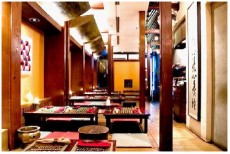
So, during a recent visit to New York City, on the suggestion of my daughter, I stepped into the Hangawi Vegan Korean restaurant on E 32nd St. After luxuriating in the hallowed rooms of the New York Public Library, we went to the restaurant, a short walk away, in Koreatown. Even as I walked into the Korean spot the atmosphere promised a rare treat for this vegetarian. However, I had to tweak the menu here and there, to make up a decent meal.
As much as the food, it was the ambience of this setting also that blew me away. First, you remove your shoes. The maître d’ ushers you into the eating spot, which is not strictly a traditional table. You are seated at floor level “tables†just 18†tall. For those with unfoldable legs, they have provided a pit just below the table into which you can leave your legs hang, touching the ground.
Kondo-esque simple decorations with Chinese and Korean characters decorate the walls. The atmosphere is one of serenity and peace. In this ambience, you just don’t eat the food. You savor it — its shades of texture, aroma, tastes and flavors. We had Korean fine noodles with kimchi and an assortment of vegetables, vegetable dumplings with rice cakes. The noise and bustle of the street, and also from other guests was muted, and you could experience the satisfying meal with total focus.
On our way out, I recalled another meal I ate years ago at Watan, an Indian restaurant, again in New York City, that attempted this ambience with a Gujarati village as the setting. Seated at round tables under a [fake] banyan tree with its overhanging branches with subdued lighting keeping the outside shut out, you could enjoy the traditional Gujarati fare with all your senses. In typical Indian fashion the food was unlimited and the meal was for a fixed price.
So, restaurants to be successful must pay attention not only to the quality — and quantity — of their fare but also to the ambience. It does not have to be lavish but has to be aesthetically pleasing. ♠
India’s Republic Day Celebrated
Posted by admin in April 2019, Past issues on April 7, 2019
By Subash Ahuja, Pittsburgh, PA
It was another first for the Indian Americans in Pittsburgh. The Indian Community celebrated an important day for India, second only to its Independence Day. It was India’s Republic Day, on January 26, 2019 at the Indian Community Center in Carnegie. Thanks to efforts of Chetan Patel (President of United Seniors Association of Pittsburgh) Krishna Sharma (Indian Community Center), the event drawing over 150 Indians of all ages in the ceremonies with the unfurling of the Indian Tricolor, went off well. There was singing of the Indian and American national anthems, other songs, speeches and dances.
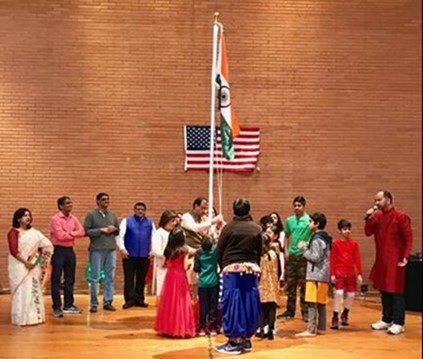
India gained its independence from the British colonial rule on August 15, 1947. However, India was still governed by a Britain-appointed governor-general, because the country did not yet have its own permanent constitution. It took the 308-member drafting committee of the 308-member Constituent Assembly more than two years and hundreds of public debates before adopting the permanent constitution.
The Constitution of India came into effect on 26 January 1950, marking the first Republic Day of India, with the indirectly elected president of India as the constitutional head of state. Dr. Rajendra Prasad was the first President of India.
While the flag of India is ceremoniously hoisted up the pole from below to commemorate gaining of independence, the flag is unfurled from the top in the annual Indian Republic Day celebrations.
The special occasion brought together many other local organizations to celebrate this special event. Priyesh Shah (Gujarati Samaj of Greater Pittsburgh), Moumita Kundu (The Bengali Association of Pittsburgh), Swatee Nanivadekar (Maharashtra Mandal), Sailesh Bokil (Pittsburgh Cricket Association), Rani Mikilineni (Pic-5K) and Preeti Paranjpe (Pitt Masti) all spoke in favor of this united initiative to keep the celebrations going forward on a regular annual basis. ♠
Indians Caught in the Transition of Persian Gulf Countries and the Arabian Peninsula
Posted by admin in April 2019, Past issues on April 7, 2019
Millions of Indians have been living on temporary work permits for decades in countries in the Persian Gulf and the Arabian Peninsula — Saudi Arabia, Oman ,Bahrain, Abu Dhabi, Dubai and others. They keep the economy going, providing cheap labor in the construction and service industries in healthcare, hospitality, retail business, and domestic help.
In the UAE, 27% of the 10.4 million population, or 2.8 million people, are Indians, overwhelmingly from Southern India. In Saudi Arabia’s 31 million population, 13%, or 4 million people, are from India, working temporarily for decades. These workers sweating it out under difficult and dangerous working conditions have been keeping the economy buzzing for decades.
The entire Persian Gulf and the Arabian countries are going through huge economic constriction in recent years, as we see in news stories in the print and visual media all over the word.

The fortunes of this region are tied to the price of crude oil since it accounts for 31% of the 82 million barrels/day of oil produced all over the world. The Middle East region holds 65% of the world oil reserves. The U.S. and Russia are major oil producers, with over 11 million barrels/day, or 14% each of the global oil production. With oil price 50% of where they were only 5 years ago (see the graph), the region is feeling the pinch. Real estate prices are no more good options for speculative investors since the prices are falling or stagnant in many places. Strangely and paradoxically, in Dubai, very rich Indians and Pakistanis are heavily invested in real estate, even as their compatriots sweat it out in poorly paid construction and service industries.
In Saudi Arabia, the generous social services to their citizens are being trimmed. Further, on temporary foreign workers from the Indian subcontinent, the Philippines, Indonesia, etc. the Saudi government has imposed per-capita taxes — that is, taxes for each person including children in the family — making it unattractive for the foreign workers to work there. The idea behind the per-capita taxes is to make it unattractive for foreign workers to bring in their family and thus to reduce the number of foreign workers, and to make the native Saudis fill the vacancies.
The Saudi government is also slowly forcing their native-born citizens to take up the regular 9-5 jobs or even work in shifts in the refineries, now sustained only with cheap labor from South Asia. But the native citizens of these regions are not used to such a grueling work routine under the harsh weather and working conditions.
To reduce the labor costs further, the employers and businesses in these countries have found an even cheaper source of work force — cheaper than what they get from South Asia. People from the Philippines and parts of sub-Saharan Africa are ready to work in the Middle East at ~50% of what the Indians are paid, as revealed in a recent Times of India story. (Source: www.tinyurl.com/Indians-Transition-PersianGulf)
In the years ahead, employers in the Persian Gulf and the Arabian Peninsula will find it economical to hire people from the Philippines and Africa. “They have multi-skills and their language skills are also good.â€
Are the state and federal governments in India studying the impact of this change on the economies in Kerala, Tamil Nadu, and parts of Uttar Pradesh, and how it will affect the social fabric? ♠
Exhibition at Pitt Looked at African Diaspora from Another Perspective
Posted by admin in April 2019, Past issues on April 7, 2019
By Donovan Harrell, Staff Writer
University Times, the University of Pittsburgh
Note: This article is reprinted with permission from University Times, a Publication of the University of Pittsburgh. Here is the link to the original article in University Times.
The African diaspora is expansive, reaching the Americas, the Caribbean and Europe. But a new University Art Gallery exhibition shows the lives and contributions of members of the African diaspora that are often overlooked: Africans in India.
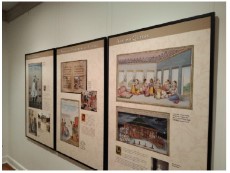
During the opening reception of “Africans in India: From Slaves to Generals and Rulers†on Feb. 15, the Pitt community heard presentations from Dr. Kenneth X. Robbins, Omar H. Ali and Jazmin Graves, renowned scholars on contributions of elite East Africans in India.
Robbins, the co-curator of the exhibition along with Sylviane A. Diouf, presented an overview of these contributions. He is a psychiatrist, collector, archivist and scholar who specializes in Indian rulers and minority groups.
Ali is the dean of the Lloyd International Honors College and professor of comparative African diasporic history at the University of North Carolina, Greensboro. He’s also the author of “Malik Ambar: Power and Slavery Across the Indian Ocean†(2016, Oxford University Press). Ambar is one of the African rulers featured in the exhibit.
And finally, Jasmine Graves, is a Ph.D. candidate in the department of Asian Languages and Civilizations at the University of Chicago and fellow at the American Institute of Indian Studies.
East Africans, according to the presenters, became generals, admirals, architects, rulers and more. Many of them made their way to these positions after being enslaved. These people were known as Habshis, or Abyssinians, and Sidis.
Upward social mobility for slaves was not common in the transatlantic slave trade. But in the Indian slave trade, Africans who showed intellectual and physical prowess were afforded social mobility.
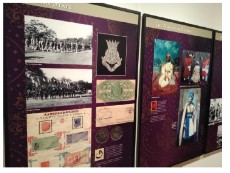
Ali said that the transatlantic slave trade has dominated the narratives of enslaved Africans in the U.S.
“And that has been shaped, and then … in some ways it’s come to over determine our ability to see Africans as almost anything other than the victims and enslaved subjects,†Ali said. “But I think it’s a function of how we’re taught history, which is very myopic in the United States.
“It’s only been a generation or two where African-American history has been given its proper sort of place in the academy, that mostly Africans and people of African descent have been sort of sidelined in the making of the modern world, which is completely incorrect.â€
This exhibition, Ali said, challenges the dominant narrative of slavery in the U.S. and shows just how vast the African diaspora is.
On loan from the New York Public Library’s Schomburg Center for Research in Black Culture, the exhibit features reproductions of more than 100 paintings and contemporary photos depicting the lives of the Sidis, according to the University Art Gallery. It has been shown at the United Nations and venues on five continents.
Mrinalini Rajagopalan, director of graduate studies in the Department of History of Art and Architecture, and Neepa Majumdar, associate professor of film and media studies in the English department, coordinated the event in partnership with the South Asia Initiative, organized by the Asian Studies Council. Rajagopalan said this exhibit brings attention to the global history of the African diaspora and how it’s affected Indian society.
“It’s a history that’s been really marginalized in Indian history,†Rajagopalan said. “So, it was important for us to really give this exhibition a platform as part of the South Asia Initiative.â€
Majumdar said this exhibition gives the Pitt community an opportunity to dialogue about the complexities of the African diaspora.
“And Pitt is a really important location for Atlantic studies, and we thought because of that, Indian Ocean studies is something we could open up a conversation about the flow of people across the Indian Ocean,†Majumdar said. “And obviously, the African diaspora — usually people think about the Caribbean, the Americas and they don’t think about Asia as much.â€
Accompanying the exhibition is “Movements,†curated by Leslie Rose, a Hot Metal Bridge fellow in art history.
The cases are filled with pieces from Pitt’s permanent collection, including documents, photographs and other artworks related to movements (migration and protests), music and more from other members of the African diaspora.
For Rose, the exhibit offers diverse representation of members of the African diaspora not often seen.
“The importance to me is seeing people,†Rose said of the overall exhibition. “For me personally, as a black woman, seeing people who look like me in spaces that I don’t commonly see.â€
The exhibit was on display between February 15 and March 21. ♠
The Untrodden Path
Posted by admin in April 2019, Past issues on April 7, 2019
By Samar Saha, Irwin, PA
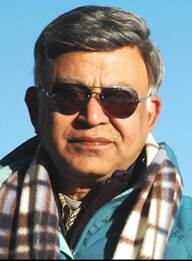
I could never figure out my nephew Birendra Narayan – nicknamed Biru. When Biru was growing up in the 80’s, we all had a real concern for him in our family. He was slow in picking up everything starting from his first spoken words. His parents took him to all kinds of child specialists in Kolkata who diagnosed him as ‘learning impaired’ – a mild form of autism. The doctors and all their medicines did not help him with his mental word processing problem, or how his brain works with words and how his mind interprets phrases and clusters of words… Biru’s parents were well-to-do professionals. They were graduates from reputed universities. Initially, they tried hard to conceal Biru’s handicap. Biru’s siblings took pity with his handicap. They were normal kids. Their main aim in life was ‘intellectual pursuit’ for getting into professional schools, colleges and hopefully, to earn bundles of money. It was not that only Biru’s extended family was in this mode; the entire Indian society was, and is, in a mad dash to climb into the ‘upper class’ society.
When such madness was sweeping over the entire country, Biru’s parents were puzzled on how to raise him. How to rear an autistic child in India? After much deliberation, they decided to put him through an unconventional schooling, meant for autistic children. Their record was not stellar, but the school did focus on children’s confidence building as a part of their education. Obviously, Biru was lacking in that department. Slowly gaining this self-confidence began to change Biru, despite his handicap. Family members began noticing this change. Steadily he completed his high school courses — not in flying colors, but with so-so grades.
Biru tried sports, music, and painting, in that order, but eventually settled on business. He turned out to be a good entrepreneur when he opened his own travel agency. His parents only knew that he worked as an employee in a travel agency. Soon he expanded his business and became a tour operator without his family knowing about it. That part of the business shot up like a rocket as the Indian middle-class income took off in the new millennium. They all now had extra money and disposable time to spend on vacations. That Biru was in this transition was Providence’s gift to him. In organizing tours for his affluent clients, Biru became so busy that he could hardly take any time off for himself even after hiring more associates. Others around him might have considered him a ‘retard’ at one point, but now, everyone saw his capability as he bloomed as an entrepreneur. For the past ten years he has been doing a prosperous business. He turned out to be a street-smart instead of a book-smart person.
So, what makes a person successful in life? More importantly, and more fundamentally, what is “successâ€? Is it fulfilling the expectation of your family? or society? or yourself at a given point in life? The term ‘successful’ is relative and so fleeting. Your own approach may be unorthodox. Your desire may be trailblazing but ‘risky,’ whereas your parental expectation could be time-tested and therefore considered ‘safe.’
We all live in this world as social beings, trying to make a living helping each other in some context. A balanced person has both inner and outer goals and yearnings as well.
A ‘balanced’ person has a strong emotional core to survive an adversity or a tragedy and make something of oneself in life. Then there are other types. These are “gifted†and “successful†individuals, seen in the context of their place and time. Often, many are self-absorbed and self-centered and suffer from alienation, loneliness, and apathy towards others. Yes, these individuals can be persons of considerable repute, wealth and power. As it happens, you can be one or the other — but cannot be both. We were all humbled when Biru showed us this truth by his own example.  ♠
India’s First Large Luxury Cruise Ship
Posted by admin in April 2019, Past issues on April 7, 2019
By K S Venkataraman, Monroeville, PA
India has over 7500 km of coastlines — 6,000 km on peninsular India and another 1500 km around the islands — Andaman, Nicobar in the Bay of Bengal and Lakshadweep in the Arabian Sea.
I have seen glossy ads for cruises to Alaska, the northeast coastlines of the US, the Caribbean islands, not to speak of cruises along the Mediterranean and the Scandinavian peninsula. So, I always wondered how nice it would be if only they have cruises along the Indian coasts catering to the increasingly affluent Indian middle class with lots of disposable income, but not a lot of disposable time. People in this bracket are too busy making money and simply to get from Point A to Point B in Chennai, Bangalore, Hyderabad, Delhi, Mumbai… and hence do not have enough time on their hands.
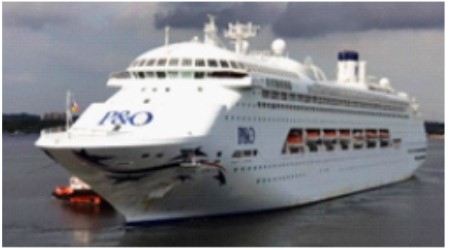
In any case, this question of mine is now answered. An Indian start up company, appropriately named Jalesh Cruises, has acquired a 2000- passenger cruise ship Karnika, which was the Pacific Jewel in its previous incarnation under P&O Australia’s flag. This ship is being refurbished in Singapore for the Indian market, and is expected to reach Mumbai in mid-April.
Jurgen Bailom, president & CEO of Zen Cruises and the exclusive agent for Jalesh Cruises, said, “Today marks an important day for the Indian cruise tourism industry.†True indeed.
There is a uniquely Indian twist to this Indian cruise story, though. No matter where Indians go, they cannot divorce themselves from their craze for foreign shores and foreign maal.
So, if you think that you can board the ship, say in Mumbai, and sail on a route touching Goa, Mangalore, Kochi/Alappuzha, Kanyakumari, and Colombo and back to Mumbai, perish that thought. For this to happen, Indians need to be more self-assured to demand cruises kissing Indian ports. For now, this cruise is for Indians from Mumbai to Abu Dhabi, Bahrain, Doha, Dubai and Muscat. This is to start in September 2019.
Bailom further said, “We will offer a memorable vacation to passengers on board with exotic culinary experiences, international hospitality and best of entertainment shows.†One hopes to go beyond the Tandoori Ghosht & Chicken and relish the Indian delicacies of the Konkan, Mangalorean, Coastal Andhra, and Bengali cuisine as well. (Source: www.tinyurl.com/Indian-Cruise). ♠
Ouvaiyaar, the Grandmotherly Tamil PoetÂ
Posted by admin in April 2019, Past issues on April 7, 2019
By K S Venkataraman, Monroeville, PA
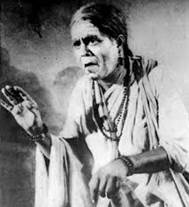
Ouvvaiyaar is a legendary— even mythical — poet in Tamil literature. With the name meaning in Tamil “The respectable Old Lady,†one can imagine the exalted place her name occupies among Tamils, whether scholars or commoners. Literary historians believe that more than one person went by the name, one in the Sangam literary time (a few centuries before the Current Era), and the other, around 10th century CE. They assert this based on the styles and the vocabulary in the poems attributed to her.
She was a Saivite, grandmotherly, austere mendicant, full of wisdom on the way of the world. Many of her poems are in four-lines Vennbaa meter. They convey profound — sometimes even cynical — messages on human frailty and emphasize the importance of education, forbearance, charity, and good conduct. Tamil cinema even made a film on her decades ago, with a man (T K Shanmugam) playing her role. See the picture above. Here are two of her famous Vennbaa verses:
First one:

All that people need are a morsel of food and six-yards of cloth.
And their life is as fragile as a clay pot.
[Yet], living blinded in ignorance of the true purpose of life,
People live till death in millions of vacillations and worries.
Here is the second one:

The large shady tree on the river bank and the good life
with royal patronage will one day tumble down;
[But] making a living with one’s own sweat is unmatched.
All other ways of earning one’s livelihood are flawed. ♠
British Airways Non-Stop Flight to London Starts in April
Posted by admin in April 2019, Past issues on April 7, 2019
By K S Venkataraman, Monroeville, PA
Beginning April 2, 2019, a new nonstop service starts between Pittsburgh International Airport and London Heathrow. The British Airways flight operates four days a week using the Boeing 787 Dreamliner, one of the newest aircraft in its fleet.
A British Airways official in his press release said, “British Airways is very excited to be returning to Pittsburgh and offering travelers a nonstop service to London and easy connections to Europe. Both cities have rich histories and bright futures and we look forward to welcoming new customers from Pittsburgh onboard very soon.â€

London and British Airways are well-connected with other parts of Asia and Africa. So, with this flight, travelers from the Pittsburgh area can save travel time by flying nonstop to London from here, and with one stop in London, they can reach Delhi, Mumbai, Chennai, Bangalore and other cities with direct flights from London. If you can put up with one more stop, you can pretty much reach any second-tier Indian city through Dubai, Doha, Abu Dhabi, or Mumbai.
The British airways flights operates on Tuesdays, Wednesdays, Fridays and Sundays departing from London Heathrow at 5:00 PM and landing in Pittsburgh at 8:15 PM. Flights will then depart Pittsburgh at 10:00 PM, arriving in London at 10:35 AM the following day.
“We are thrilled to have British Airways serving our region nonstop to London once again,†said Christina Cassotis, Pittsburgh International Airport CEO. “We are looking forward to working together to ensure the flight is a success.â€
Craig Davis, president and CEO of VisitPITTSBURGH, an organization dedicated to promote tourism in Pittsburgh said “The mission of VisitPITTSBURGH is to bring Pittsburgh to the world and the world to Pittsburgh. This flight will help us draw even more international travelers and strengthen our status as a premier destination.†♠
Home:
Dunkin Donuts Gets Drowned in India
Posted by admin in April 2019, Past issues on April 7, 2019
So this news tidbit stopped me on my tracks!! Dunkin Donuts closed shop on nearly half of their stores in India!! They had started with great fanfare in 2012 and used the same franchise with which they launched the Domino’s Pizza chain in India. But this time, Dunkin Donuts did not catch on!

For starters, the unhealthy sugary and oily donut franchise targeted young adults comprising college students and young kids, who were already successfully targeted by McDonald’s, KFC and other fast food giants. But even these chains too were forced to cater to Indian taste buds and palates by spicing up their bland items, and offered altogether new items such as McDonald’s paneer wrap and other spicier offerings. KFC with its fried chicken mainstay appealed to the chicken-gorging Indians.
The donut items were priced for youngsters from affluent homes or for working folks with disposable incomes to spend on these not entirely healthy fares. Typical steamed-milk-added coffee, appropriately named Dunkaccino, was priced at Rs 160, and a single donut was at Rs. 62.
But still, where did Dunkin slip? Theirs is the only franchise that did not catch on in India. Remember, fast food business is a cut-throat business. Working on thin margins, they depend on volume in sales to make a profit.

A recent story in the Economic Times cited several reasons. First and foremost, Indians were not used to a grab-and-go breakfast culture. Even if you drive to work, it will be difficult to eat while driving on Indian roads. In the chaotic and unruly Indian traffic, not only pedestrians, but also other 2-, 3- and 4-wheeler vehicles do not follow any traffic rules. Already, young Indians have enough distractions while traveling, like texting and messaging on their iPhones, and talking to their buddies. You can add one more item to this multi-tasking group at great peril with accidents. Second, Indian prefer to sit down and eat a hot breakfast at home before leaving for work. The top 10 Indian breakfast items include such fare as Idli, Dosa, Upma Poha or Aloo Paratha, none of them sweet. Older adults prefer oatmeal with dahi or buttermilk or the more traditional ragi-based porridge.
Dunkin tried to tease the Indian palate again by introducing mango and lychee flavored donuts but these still did not produce the magic of burgers and pizzas.
Indians view donuts as a dessert offering and consider it more like a luxury to indulge in once in a while. The idea of eating something sweet first thing in the morning just did not click. So Dunkin beat a retreat from Indian markets, looking for more sweet pastures elsewhere. ♠
Home:
Congressman Conor Lamb Visits CCAC North Campus
Posted by admin in April 2019, Past issues on April 7, 2019
By Srujana Kunjula, Wexford, PA
Editor’s note: Dr Srujana Kunjula, who holds a PhD from the Jawaharlal Nehru University in India, teaches sociology and political science at CCAC.

Many high school graduates are not able to go to 4-year degree colleges for a variety of reasons. Among them are the high cost of 4-year degrees in universities, and “missing the bus†during their high school years due to family situations, not getting proper directions and guidance during critical transition years as young adults. Whatever the reason, as a society, we need to recognize that we help ourselves by helping all our youngsters to become productive, skilled employees and tax-paying citizens. Otherwise they end up as a burden to society.
Besides, with the rapid development in technology in all facets of our life, it is imperative that we train and re-train all our workforce to make these transitions smooth for the employees, and more importantly, the the employers as well. The community college system all over the country provides a vital service in delivering an educated and trained work force for many jobs for a whole range of manufacturing and service-sector industries. It is laudable that the community college system does this at an affordable cost by giving a second chance to students, many of them in their thirties and forties. — Editor
———-

Mr. Conor James Lamb, the U.S. Representative for Pennsylvania’s 17th congressional district, visited the Community College of Allegheny County (CCAC)’s North Campus on February 19, 2019. The Campus president, Gretchen Mullin-Sawicki, put the visit in context: “We welcomed Congressman Lamb with administrators, faculty, industry, and student presentations to provide a comprehensive vision of CCAC’s commitment to workforce development and student career readiness. We were delighted to showcase our talented CCAC community to the Congressman and his staff.â€
After the welcome remarks by CCAC president Quintin Bullock, CCAC’s North Campus president Gretchen Mullin-Sawicki provided a nice overview of CCAC’s workforce development programs in Health Care, Information Technology, Engineering, Science & Production, Business & Financial Technology, Construction, and Retail & Hospitality, and its emphasis in developing technical and soft skills in students. Academic Dean, Dr. Jeffrey Thomas, introduced industry partners from WesBanco, IT Strategy & Innovations and Management Science Associates who thanked CCAC for sending trained students to their companies. Students from West Allegheny High School explained how they are benefitting from early college programs provided by CCAC.
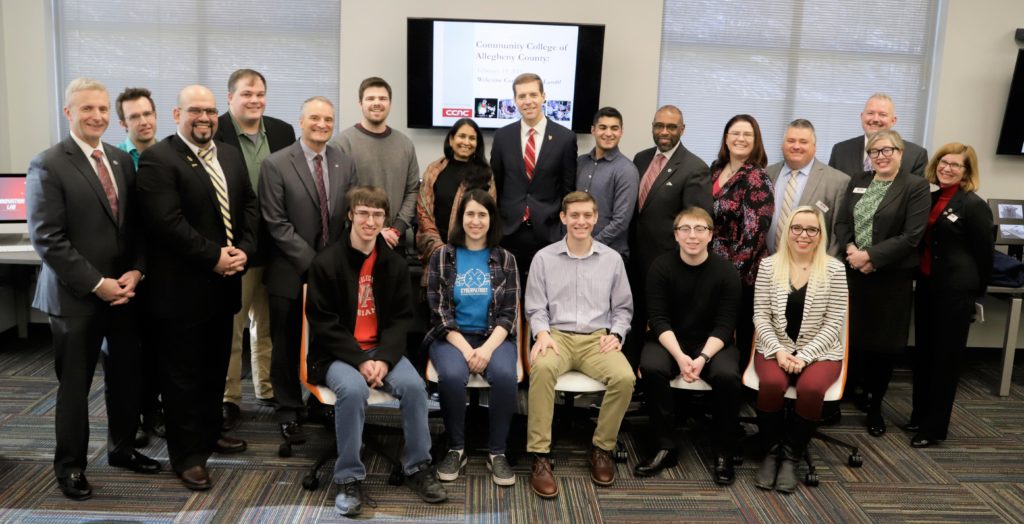
Dr. Mary Lou Kennedy, Dean of Students, introduced faculty and students to Mr. Lamb. Professors Eric Darsow and Rebecca Elinich highlighted Cyber Security, Data Analytics, Simulation and Gaming programs and projects. The Student Government Association president, Kaylor Dobbs, described how he worked with the administration representing student interests.
Zain Aaban, Honors leadership scholar elaborated on how the honors program enriches students through honors courses, research projects, field trips, guest lectures, operas, musicals, rock climbing and community service initiatives. Fernando Tapia Tinoco from Ecuador expressed gratitude to CCAC for giving him the possibility of treating his son’s heart disease. Dr. Kennedy said, “We had the opportunity to showcase the talent of our students both in and out of the classroom as well as highlight the skills our students are learning through their active involvement on campus.â€
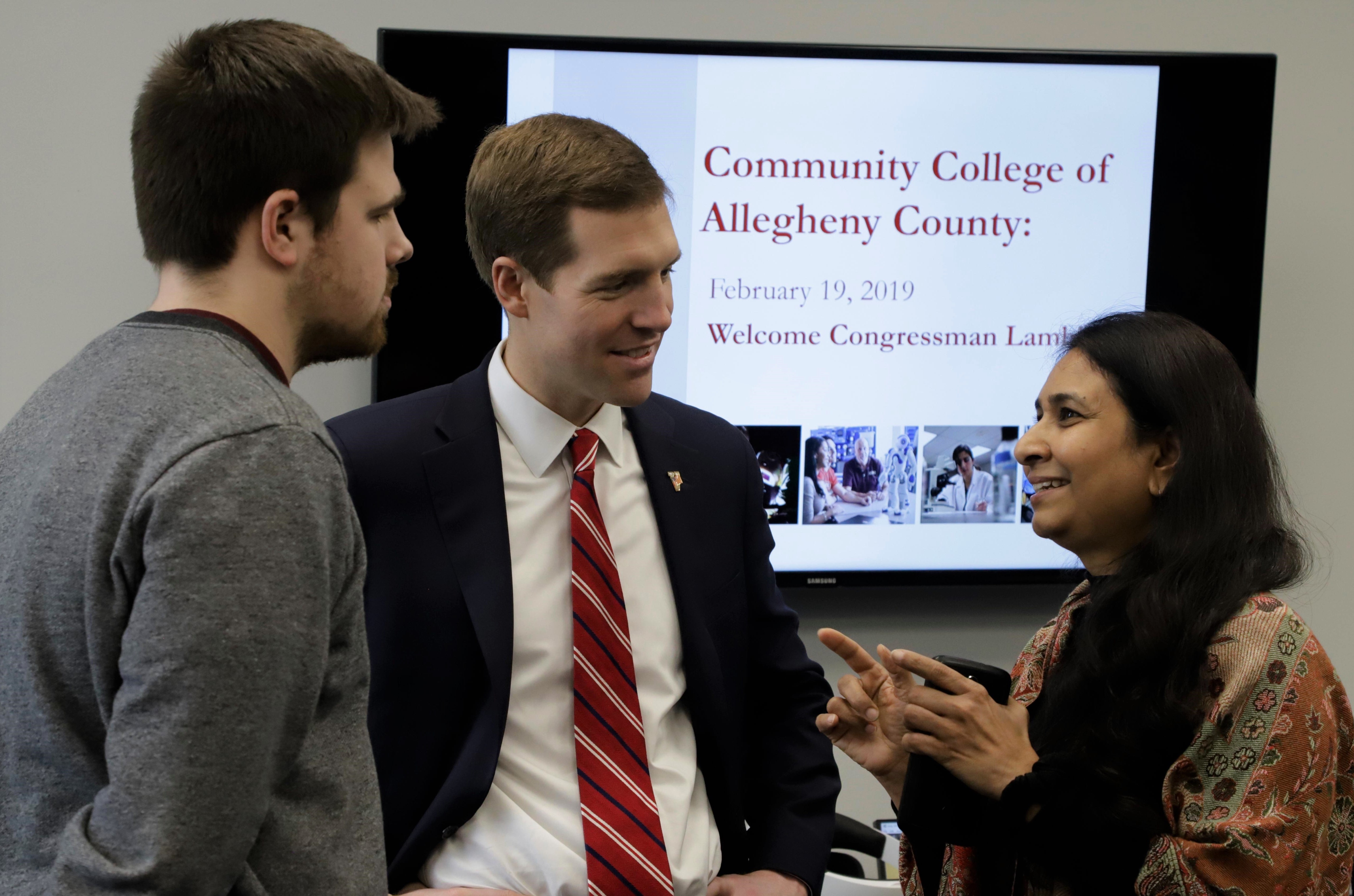
Conor Lamb listened to all the presentations with interest asking questions. In his remarks at the end, he reiterated the valuable role CCAC plays in this region, promising he will be its strong advocate. He spent time interacting with faculty and students after the program. My student Jaron Snavely remarked, “I am thankful to meet Conor Lamb and ask his views on the state of the Democratic Party, ‘Green New Deal’, and its impact on Western PA constituents. He gave thoughtful answers and seemed to care about my opinions and concerns.â€
I had the opportunity to share my academic experiences with Representative Lamb. He is personable, enthusiastic, supportive, and down-to-earth. The fact that he took time out of his busy schedule to learn about our college exemplifies his curiosity and commitment to people-centered politics. ♠
Home:
Amazon’s Arrogance
Posted by admin in April 2019, Past issues on April 7, 2019
By Kollengode S Venkataraman, Monroeville, PA
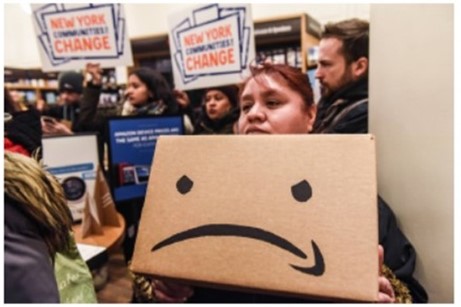
After a one-year long search, Amazon announced that its HQ2 project in Novrmber 2018, with the potential to employ 50,000 employees, would be split ,between two large metropolitan areas, namely, New York City (population 8 million) and the Washington DC area (over 6 million), both on the eastern seaboard, hardly 250 miles from each other. The project, with an outlay of $5.0 billion, is expected to provide employment for 25,000 people in each location. The two locations are the 1st and the 7th largest metropolitan areas in the nation. New York City is already the capital of TV news media houses, financial markets, ad agencies, and with all other cultural accoutrements such as museums, sports, theater, music and dance… The DC area is the political epicenter of the nation with top-flight universities, several thousand lobbying houses for every conceivable special interest group, and all the trappings for the “good life,†with all kinds of tax-payer subsidized attractions like parks, museums and monuments. And the DC area, for a variety of reasons, is the most recession-proof regions in the nation. The pictures in this story show the public anger against Amazon’s arrogance.
No matter where Amazon moves its HQ2 and HQ3, tax payers will be coughing up over $2 billion in tax subsidies and abatements for several years. This is nothing new. In the US, cities vie with each other to attract new glamorous businesses with the potential to offer thousands of jobs or give national visibility. Sports teams, healthcare facilities, or airlines looking for opening a new hub talk to second- and third-tier cities seeking all kinds of financial subsidies for them to come. Cities such as Pittsburgh, Cleveland, Cincinnati, Denver and others desperately looking for new businesses to grow, are willing to give all kinds of concessions and tax breaks. So, getting tax-payer funded financial subsidies even for mega companies such as Amazon, is par for the course in the American business environment.
But what was diabolical with Amazon was the way it went about teasing all the metro areas to make their offers while meeting certain minimum criteria before sending their proposals. Among the criteria it listed when it released the RFP (Request for Proposal) from cities were:
1. Metro area with at least 1 million in population; space of 8 million square feet for its buildings a) within 30 miles of the population center and b) under 45 minutes from an international airport with nonstop flights to Seattle, San Francisco/Bay Area, New York, and Washington DC. Its Seattle HQ sits on an 8 million sq.ft site with 33 buildings.
population center and b) under 45 minutes from an international airport with nonstop flights to Seattle, San Francisco/Bay Area, New York, and Washington DC. Its Seattle HQ sits on an 8 million sq.ft site with 33 buildings.
2. Stable and business-friendly regulations and financial incentives and subsidies from state and local governments (essentially tax-payer money). The company also asked the applicants — mind you, the applicants are cities and large metro areas with elected governments — to outline the specific types of incentives they offer, such as tax credits and relocation grants, and calculations on the amount of total incentives they provide.
3. Since Amazon wanted to hire 50,000 employees, the applicant cities were also asked to submit the names of the universities, community colleges, vocational schools with the details of the student enrollment statistics and the majors they offer.
4. Amazon was also asking for what it called “cultural fit†in these terms: it defined cultural fit to include a diverse population, strong higher-education system, and local government “eager and willing to work with the company,†among other features. So, Amazon was in the driver’s seat, not the elected state and local governments responding to its needs. Amazon also asked the cities to “demonstrate characteristics of this [cultural fit] through testimonials from other large companies.â€
5. Amazon wanted the site with mass transit — train, subway, or bus — no more than one or two miles from highways and connecting roads.
6. The company asked the applicant cities to identify “all transit options, including bike lanes and pedestrian access†for the proposed site and to rank traffic congestion during peak commuting hours.
7. Amazon also asked for information about housing prices and availability, the general cost of living, and crime statistics from each of the metropolitan areas.
Nearly 240 cities and metropolitan areas responded to Amazon’s call. Since many cities or counties all by themselves rarely meet all these criteria, elected officials in many areas got together with adjoining cities and counties, spent hundreds of hours and thousands of dollars to make their proposals in glossy and eye-catching video presentations.

Amazon whittled down the proposals from 238 communities to 20 Metro areas as “finalists,†much like bikini-clad beauty contestants are chosen; or worse still, like some modern day dating show. Amazon humiliated the 20 finalist metro areas by publicly teasing them by, all the while drumming up publicity for itself among different sections of society. The finalist cities were desperate to be picked up by the Prince on the White Horse.
Among the twenty “finalist†metro areas that Amazon whittled down were: Indianapolis, Chicago, Denver, Nashville, Los Angeles, Dallas, Austin, Boston, New York City, Pittsburgh, Philadelphia, Columbus, Ohio; Washington, DC Metro area, Raleigh, NC; and Atlanta.
After getting all kinds of information from 238 metro areas, and whittling them down to 20 smaller metros, when Amazon decided to split its decision between New York City and the Washington DC area, the two largest metro areas barely 250 miles apart, people and elected officials all over were irate. Many social commentators berated Amazon, stating that Amazon’s objective in this exercise was not on the second HQ, but to gather at no cost to itself all kinds of information and then use it for its other business purposes down the pike. Cowing down to pressure, New York said NO, and soon Amazon withdrew from New York City.
This is the finest example of what happens when we let Corporate America’s big wigs such as Amazon run amuck and roughshod over elected state and local governments all across the nation. And how public outcry can outsmart corporate high-handedness. ♠


